If black and white true-breeding mice are mated and the result is all gray offspring, what inheritance pattern would this be indicative of?
Incomplete dominance.
ABO blood groups are an example of:
Multiple alleles and codominance.
Could an individual with blood type O (genotype ii) be a legitimate child of parents in which one parent had blood type A and the other parent had blood type B?
Yes, if each parent carries one i allele.
A white splashed (Bl/Bl) Andalausian chicken and a black (bl/bl) Andalusian chicken are crossed. The heterozygotes produced show an intermediate phenotype (blue). What inheritance pattern would this be indicative of?
Incomplete dominance.
A person with only one Sickle Cell Anemia allele and one unaffected allele will have some normal red blood cells and some abnormal. What inheritance pattern would this be indicative of?
Codominance.
In a mating between two individuals that are heterozygous for a recessive lethal allele that is expressed in utero, what genotypic ratio (homozygous dominant:heterozygous:homozygous recessive) would you expect to observe in the offspring?
1:2:0
In rats, gene B produces black coat color if the genotype is B-, but black pigment is not produced if the genotype is bb. At an independent locus, gene D produces yellow pigment if the genotype is D-, but no pigment is produced when the genotype is dd. Production of both pigments results in brown coat color. If neither pigment is produced, coat color is cream. The genotype of parents of litters with the following phenotype distribution 3 brown, 3 yellow, 1 black, 1 cream is:
BbDd x bbDd
In rats, gene B produces black coat color if the genotype is B-, but black pigment is not produced if the genotype is bb. At an independent locus, gene D produces yellow pigment if the genotype is D-, but no pigment is produced when the genotype is dd. Production of both pigments results in brown coat color. If neither pigment is produced, coat color is cream. The phenotype of parents of litters with the following phenotype distribution 3 brown, 3 yellow, 1 black, 1 cream is:
Brown and yellow.
The wild-type coat color, agouti (AA) is dominant to solid-colored fur (aa). However, a separate gene C, when present as the recessive homozygote (cc), negates any expression of pigment from the A gene and results in an albino mouse. Therefore, the genotypes AAcc, Aacc, and aacc all produce the same albino phenotype. A cross between heterozygotes for both genes (AaCc x AaCc) would generate offspring with a phenotypic ratio of 9 agouti:3 black:4 albino. Which type of gene interaction is this?
Recessive epistasis.
Wild type blue-eyed Mary has blue flowers. Two genes control the pathway that makes the blue pigment: The product of gene W turns a white precursor into magenta pigment. The product of gene M turns the magenta pigment into blue pigment. Each gene has a recessive loss-of-function allele: w and m, respectively. A dihybrid (WwMm) is self-pollinated. What proportion of the offspring will be magenta?
3/16
When genes are on different chromosomes, what percentage of gametes produced by a double heterozygous individual will be recombinant?
50%
A species has n=4 chromosomes. Genes on the same chromosome have a maximum recombination recombination rate of:
50%
A species has n=4 chromosomes. Genes on the same chromosome have a minimum recombination recombination rate of:
0%
You are studying two linked genes that influence vine height and fruit color in squash. Yellow color is dominant over green, and tall height is dominant over short. You get the following numbers of offspring from your testcross: 198 Tall Yellow, 192 Short Green, 54 Tall Green, and 56 Short Yellow Which offspring are recombinants?
Tall green and short yellow
You are studying two linked genes that influence vine height and fruit color in squash. Yellow color is dominant over green, and tall height is dominant over short. You get the following numbers of offspring from your testcross: 198 Tall Yellow, 192 Short Green, 54 Tall Green, and 56 Short Yellow What is the distance between these genes?
22 cM
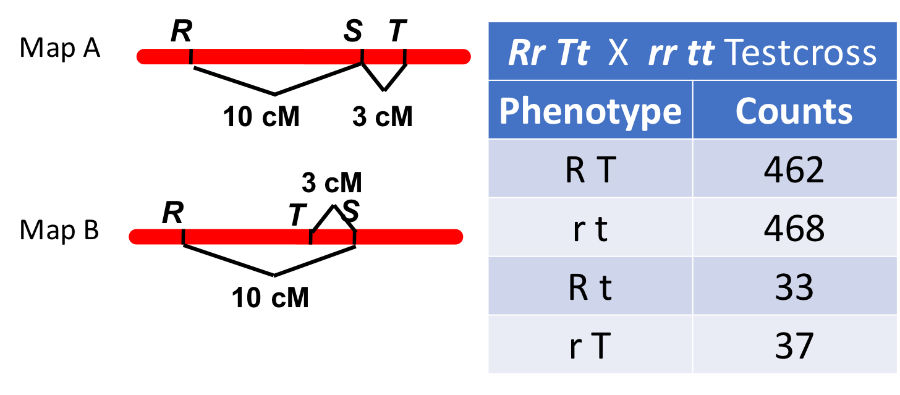
Which map is correct?
Map B
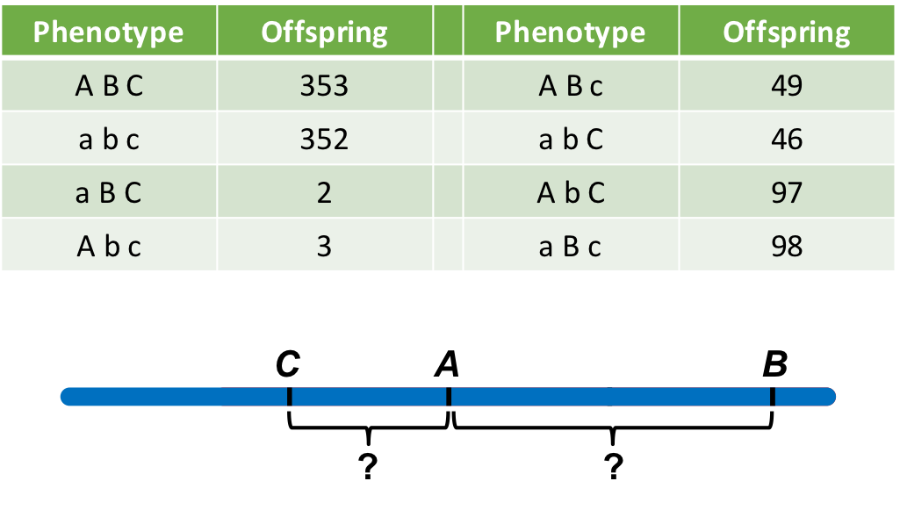
Based on the data provided, what is the distance between genes C and A?
10 cM
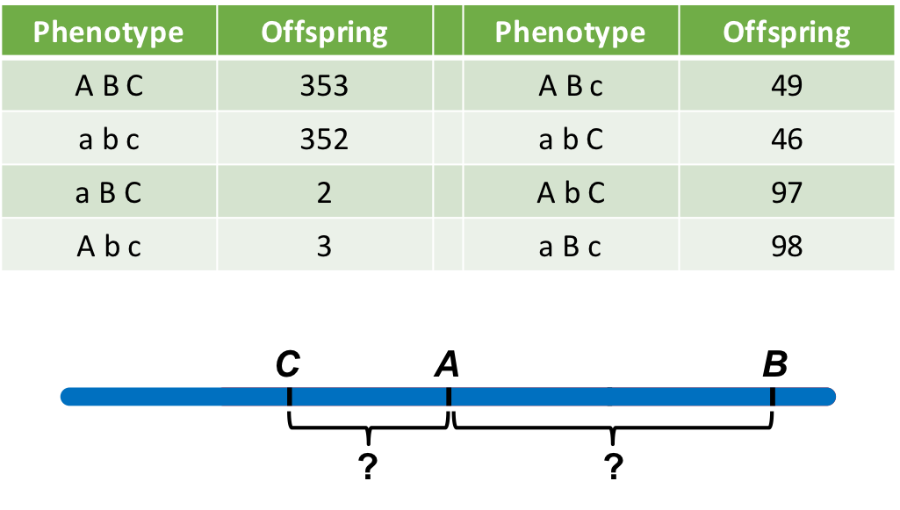
Based on the data provided, what is the distance between genes A and B?
20 cM

Given the genetic map of genes D, E and F. What is the expected frequency (probability) of double crossovers?
3.75 %

A three-point test cross revealed a total of 11 double crossovers among a total of 726 test-cross progeny. Using the genetic map provided, calculate the coefficient of Interference (I).
I = 0.6
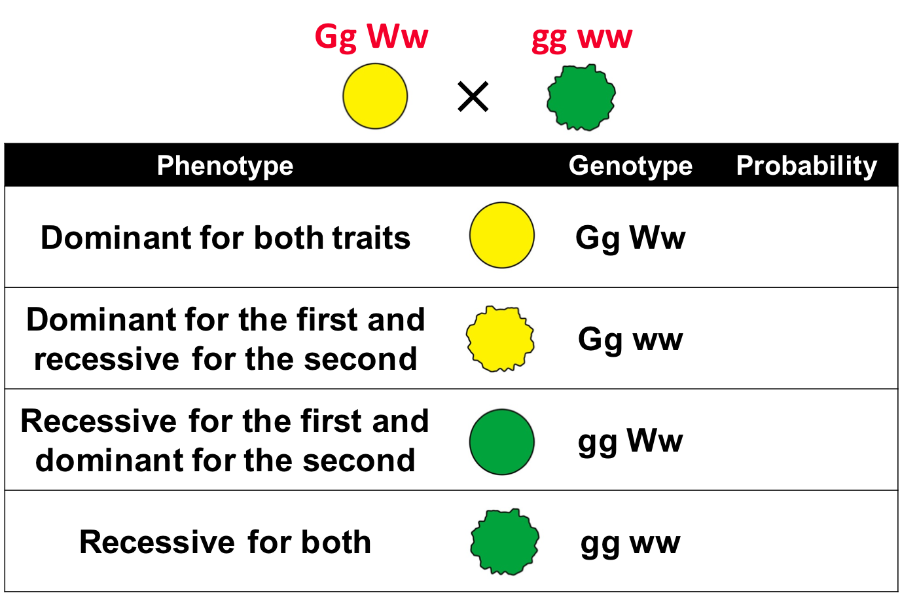
What is our null hypothesis for genotype ratios?
1:1:1:1

What is the chi-square value?
64
There are two forms of human earwax: wet and dry. W is a dominant allele that produces wet earwax. In a sample of Swedes, you measure the following genotypes: WW= 810, Ww =180, and ww = 10 What is the allele frequency of W?
90%
There are two forms of human earwax: wet and dry. W is a dominant allele that produces wet earwax. In a sample of Swedes, you measure the following genotypes: WW= 810, Ww =180, and ww = 10. What proportion of carriers of dry earwax (people carrying at least one copy of w) are heterozygous?
95%

There are two forms of human earwax: wet and dry. W is a dominant allele that produces wet earwax. Individual 1 has dry ear wax and 2 has wet earwax. What is the probability that an offspring of II-1 and II-2 has dry ear wax?
9%
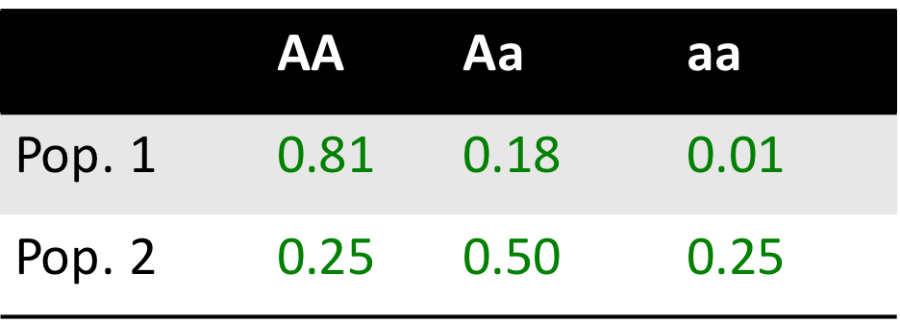
Calculate the Fixation index in the Subpopulation relative to the Total population based on the information provided.
0.19
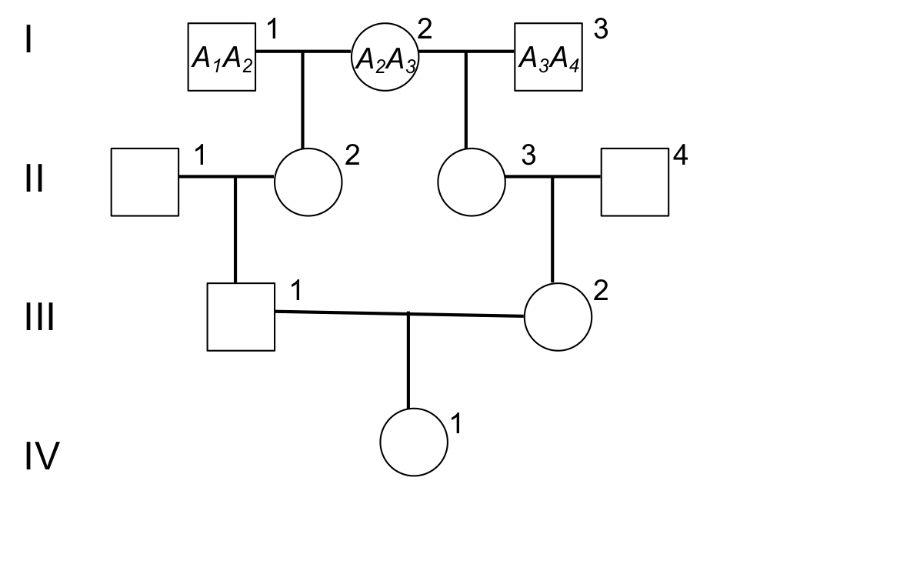
Who is/are the common ancestor (s) of individual IV-1?
I-2
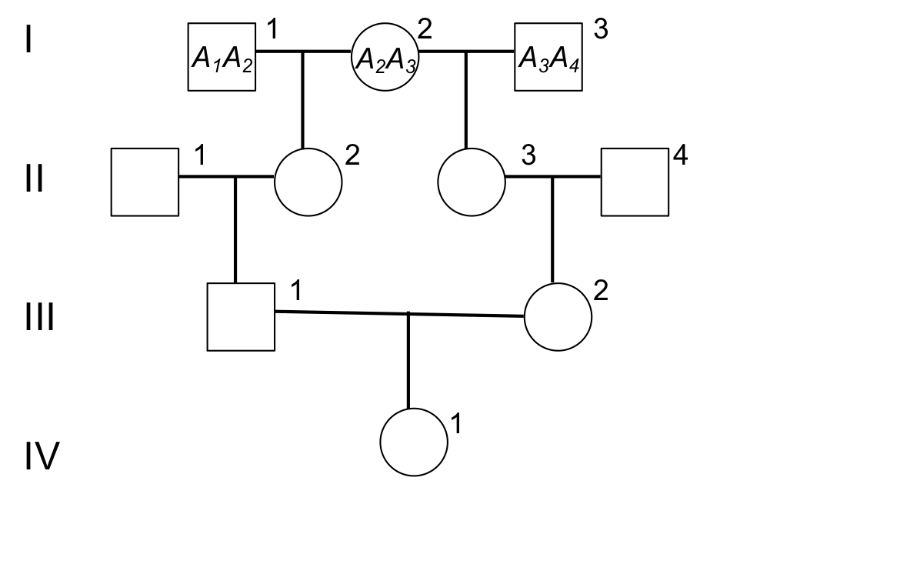
How many transmission events (n) are needed for one allele to be IBD in IV-1?
6
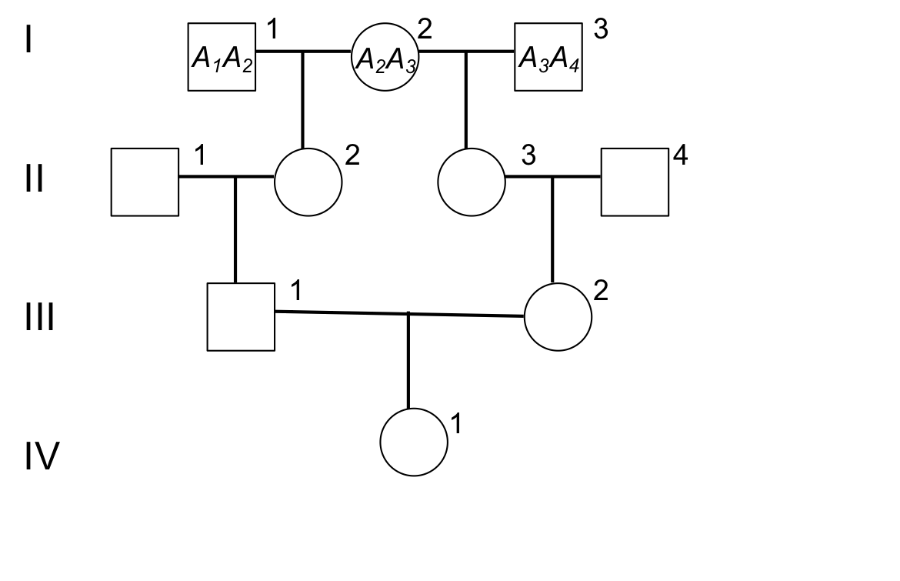
What is F for individual IV-1?
1/32
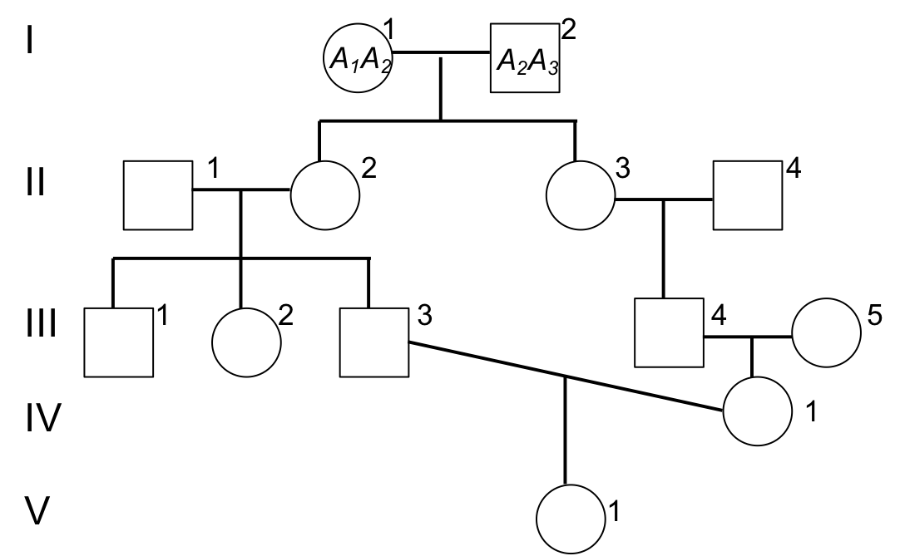
What is the probability of one allele to be IBD in V-1?
1/128
Which hemoglobin genotype has the highest fitness in an area of high malaria infection?
HbAS
Which hemoglobin genotype has the highest fitness in an area of low malaria infection?
HbAA
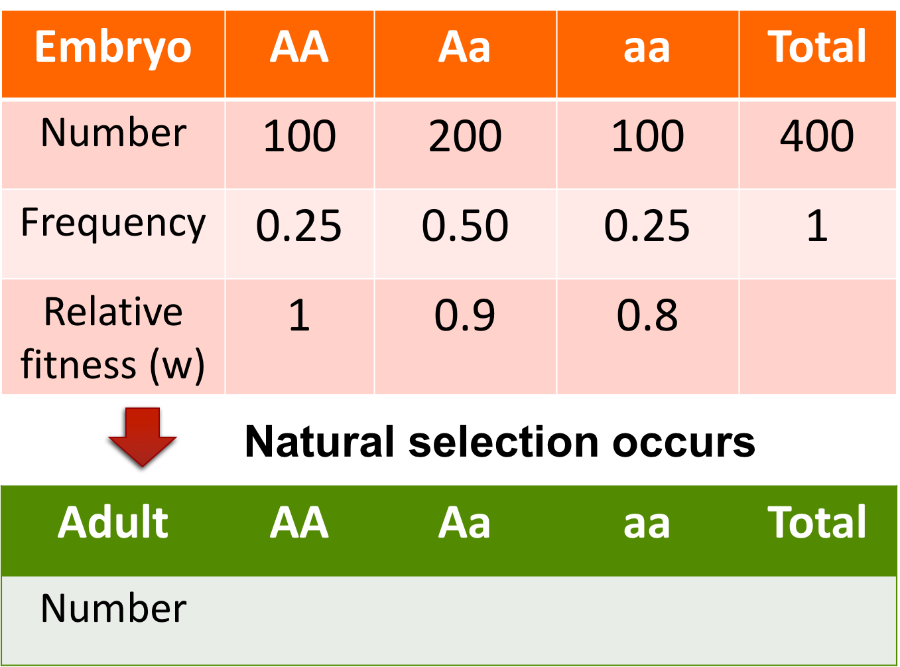
Based on the information provided, what is the number of adults?
AA=100, Aa=180, aa=80
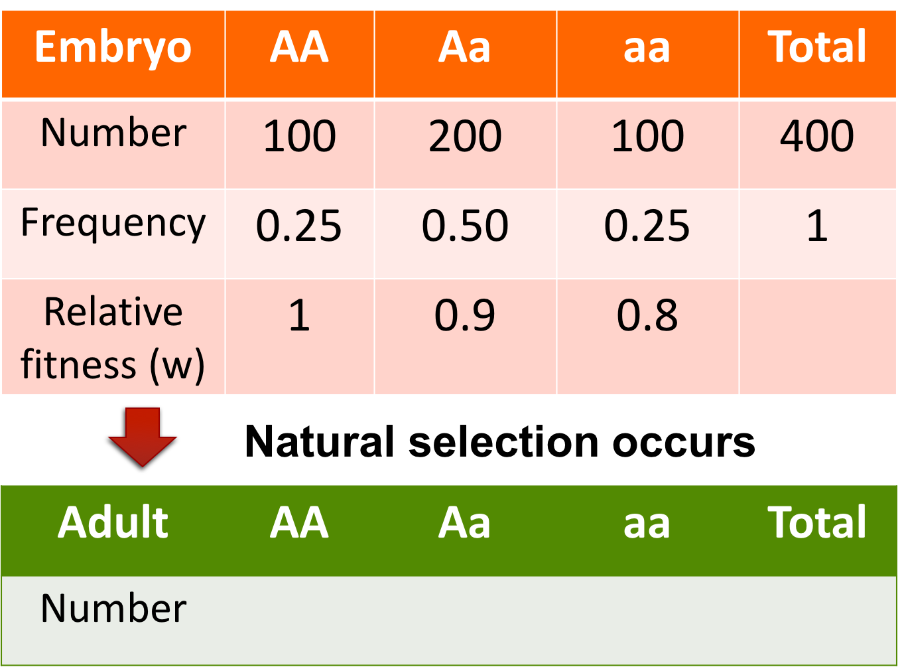
Based on the table, calculate the frequency of allele A in the adults.
0.53
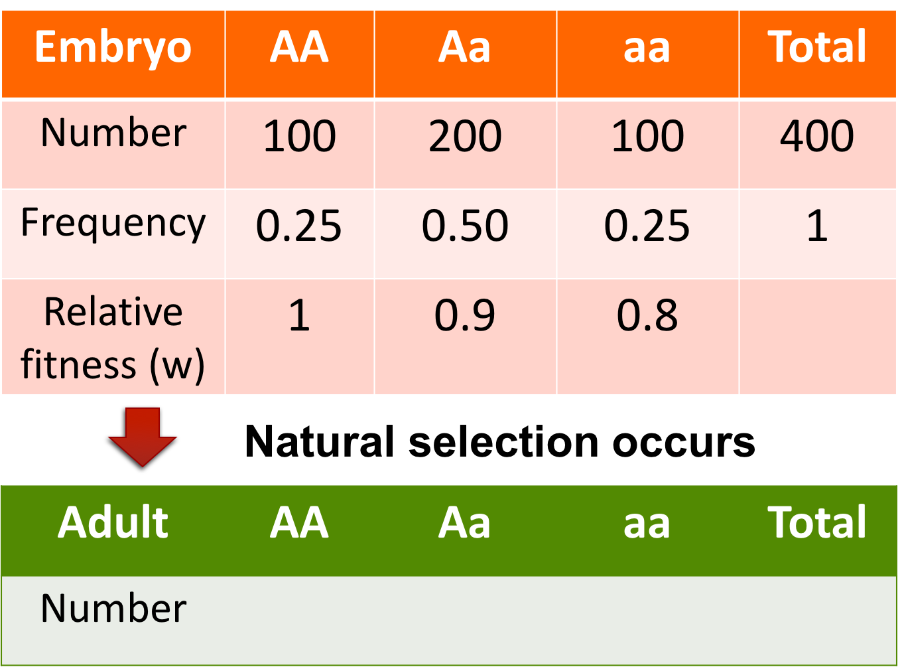
What is the value of Delta A?
0.03
In a large experimental Drosophila population, the relative fitness of a recessive phenotype is calculated to be 0.90, and the mutation rate to the recessive allele is 5 x 10^-5. If the population is allowed to come to equilibrium, what allele frequencies can be predicted?
q hat = 0.022 and p hat = 0.978
The relative fitness values of three genotypes are: wAA = 1.0, wAa = 1.0, and waa = 0.7. If the population starts at the allele frequency p = 0.5, what is the value of p in the next generation?
0.54
The relative fitness values of three genotypes are: wAA = 1.0, wAa = 1.0, and waa = 0.7. What is the predicted equilibrium allele frequency if the rate of mutation of A to a is 2 x 10^-5?
q hat = 0.008 and p hat = 0.992
In a population of 50,000 diploid individuals, what is the probability that a new neutral mutation will ultimately reach fixation?
0.00001
In a population of 50,000 diploid individuals, what is the probability that a new neutral mutation will ultimately be lost from the population?
0.99999
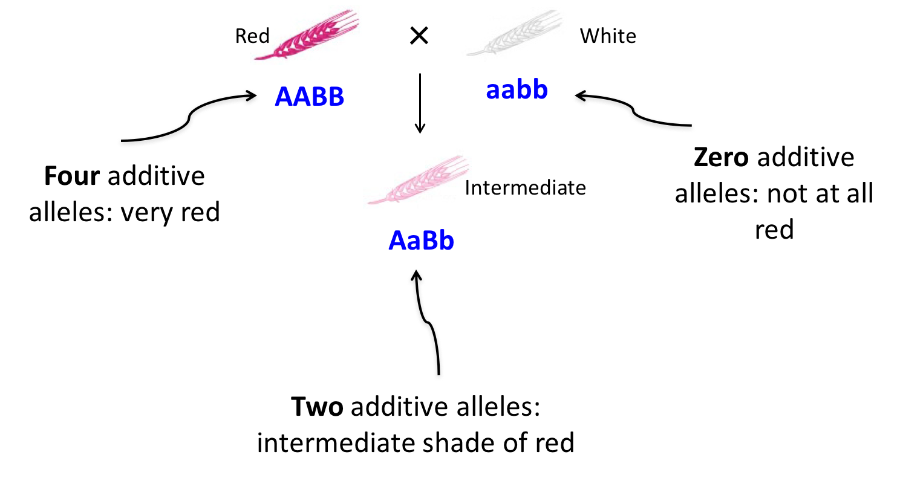
If AaBb plants self-fertilize, what proportion of the progeny will have exactly one dominant allele?
4/16
How many distinct phenotypes exist for a trait controlled by three additive loci?
7
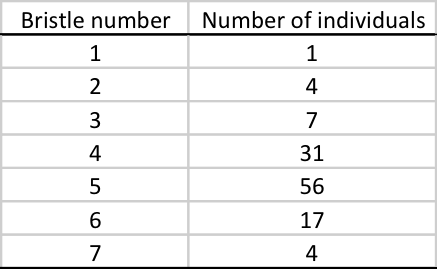
The table shows the distribution of the number of bristles in a Drosophila population indicating how many individuals in the population have those particular number of bristles. Calculate the mean number of bristles in the entire population.
4.7
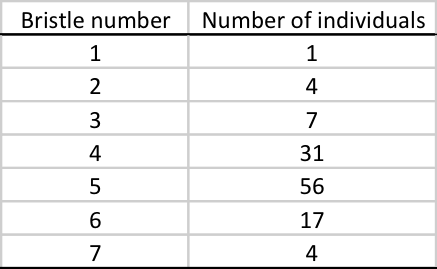
The table shows the distribution of the number of bristles in a Drosophila population indicating how many individuals in the population have those particular number of bristles. Calculate the variance for the number of bristles in the entire population.
1.11
A plant breeder is attempting to breed a variety of corn with high oil content. Each generation, he crosses only those plants that have the highest oil content. Over time, the average oil content of his plants increases. He does this with two strains of plants. For Strain A, h2 = 0.3. For Strain B, h2 = 0.6. Which strain will more quickly increase in oil content with selection?
Strain B
You buy two sets of flowers from the same species, one set is only made of red flowers, while the other is made of white flowers, and you know both sets were produced by only red and white parents, respectively. Assume flower color is coded by a single autosomal gene. After crossing red flowers with white flowers, all the offspring are banded red and white. What can you say about the alleles R and W of the flower color gene?
R and W are codominant
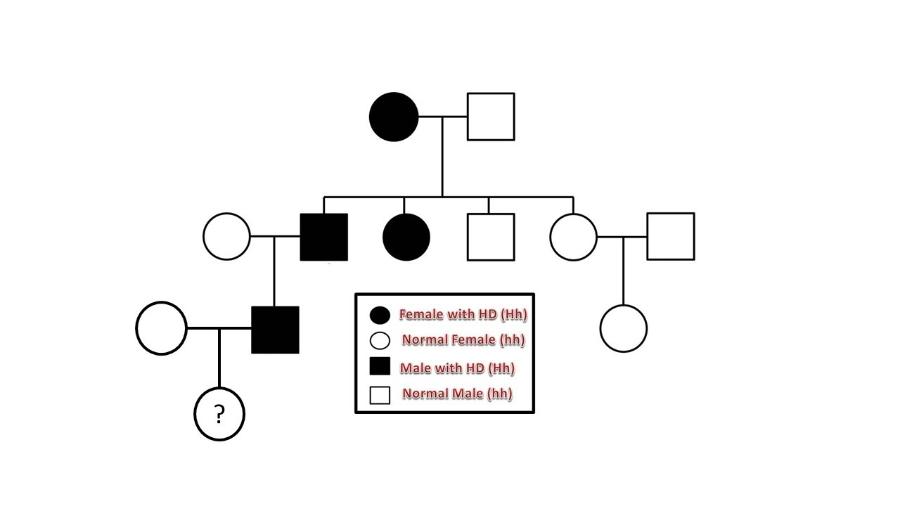
Huntington’s disease is a rare neuro-degenerative disease which appears late in life and causes motor function issues and dementia. The following pedigree shows the progression of the disease through a family through multiple generations. What can you say about the genetic aspect of the disease?
It is caused by an autosomal dominant allele
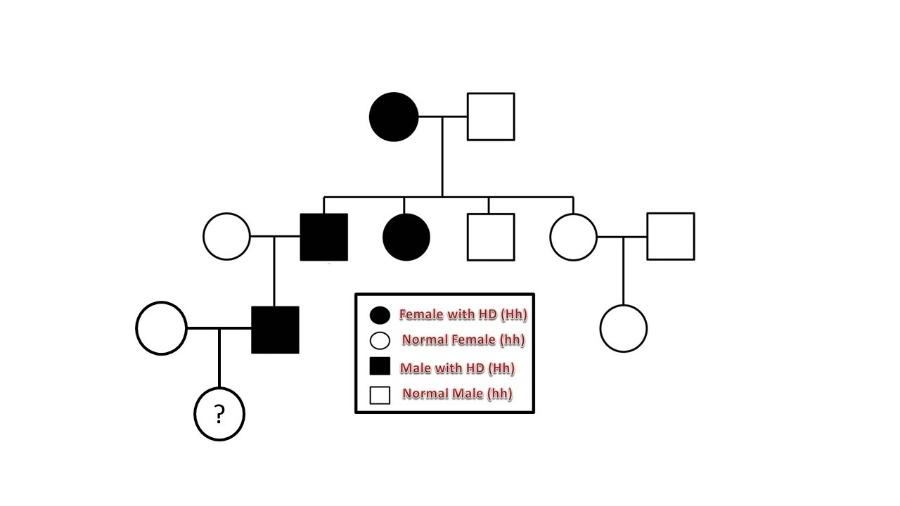
The woman marked with a question mark is your friend. Knowing that you are taking Genetics, she comes to ask you for advice: she wants to have children, but is afraid that they will be sick with the disease. Her husband and her mother have no family history of HD. What is the probability that she is sick? What is the probability that her children will be, without knowing her own status regarding the disease?
P(friend sick) = ½ ; P(child sick) = ¼
Your friend gets tested and the results are conclusive: she will not develop Huntington’s disease. What is the probability of her child having the disease now?
0
Which of these statements is correct?
a. Syntenic genes are located on the same chromosome.
b. Linked genes are always syntenic.
c.You cannot always predict the relative genetic distance from their physical distance on a chromosome.
d. All of the above.
All of the above.
What is the relative genetic distance between two linked genes if the recombination frequency is 0.32?
32 cM
What statement best explains the distortion in Mendelian ratios observed by Bateson & Punnett in 1905? (Reminder: they found an overrepresentation of F2 offspring showing both dominant or recessive phenotypes, and an underrepresentation of offspring displaying one dominant and one recessive phenotype)
Gene linkage: Genes for flower color and pollen shape are physically close on the same chromosome, leading to a breakdown in the independent assortment of the alleles for these traits.
A lab runs a cross of a wild type silk moth and a tester moth and produces 800 offspring as a result. Given the information in the table below, what is the recombination frequency of the cross?
0.1
When determining the relative genetic distance between two genes, why is dihybrid back-cross preferable over traditional dihybrid cross?
Genotypes of the offspring can be determined based on their phenotype.
Why do we map genes?
a. To understand how genes interact with each other
b. Comparative genomics analysis
c. To determine the genotype of an organism
d. All of the above
d. All of the above
What gives rise to different variations of traits within a species?
Different alleles of a gene
Crossing true breeding dark-coated sheep with true breeding light-coated sheep always results in 100% dark-coated offspring. You are screening a population of 300 Soay sheep for coat color, and you count 224 dark sheep and 76 light sheep. What is the genotype frequency of the homozygous recessive sheep for TYRP1 gene if the population is in Hardy-Weinberg equilibrium?
0.253
In the same population, if it is under Hardy-Weinberg equilibrium, how many individuals do you expect to be heterozygous at TYRP1?
150
Rabbit’s ears can be either short (dominant) or floppy (recessive). If a population of rabbits in Hardy-Weinberg equilibrium has 250 short eared rabbits and 100 floppy eared rabbits, what is the allele frequency of the “short” allele?
0.465
You are observing the suit (clubs, diamonds, hearts, or spades) of a randomly drawn card from a deck. What is the degree(s) of freedom if you were to perform the Chi-square test on the expected and observed outcome of the suits of the cards?
3
You perform a Chi-square test for gene X and find the p-value to be between 0.05 and 0.01. What can you say with 95% certainty about this population?
This population is not in Hardy-Weinberg equilibrium at the X locus: geneX is influenced by at least one force of evolution.
Which of the following best describes the evolution of giraffe’s long neck by natural selection?
a.Ancestors of giraffes did not need long necks to survive, but random changes in allele frequencies in the population resulted in more offspring inheriting the long neck genes.
b.Ancestors of giraffes that happened to be born with long neck genes were able to reach the leaves on high branches, which allowed them to survive and reproduce better than the others in the population. More offspring with long neck genes were born in the next generations.
c.Ancestors of giraffes wanted to evolve long necks to reach the leaves on high branches. The offspring of those giraffes inherited that wish and grew longer necks.
d.Ancestors of giraffes kept stretching their necks to reach the leaves on high branches. Their necks got longer throughout their life, which allowed them to survive and reproduce better than the others in the population who did not stretch their necks. Offspring in the next generation inherited that acquired trait.
b. Ancestors of giraffes that happened to be born with long neck genes were able to reach the leaves on high branches, which allowed them to survive and reproduce better than the others in the population. More offspring with long neck genes were born in the next generations.
Which of the following best describes the fitness of organisms?
How well the organisms survive and reproduce in an environment.
In an experiment, brown beetles were painted green with non-toxic paint. Green beetles in a green environment are less likely to be spotted by birds and eaten. Offspring of painted parents are brown, just like their parents before they were painted. Which of the conditions of Natural Selection is not met here?
Heritability: The painted-on body color was an acquired characteristic that would not be passed down from parent to offspring.
How does the mean relative fitness change from one generation to the next in response to selection, assuming the population is not in equilibrium and the relative fitness of each genotype does not change? (hint: try calculating the expected mean relative fitness of the future generation in the example given in the slides)
Mean fitness increases from one generation to the next.
You observe a herd of Banthas in the desert of Tatooine. Their tail length is controlled by a single gene where dominant T1 allele and recessive T2 allele code for long and short tail, respectively. Table below shows the current and expected future genotype frequencies in this population:
Short tail
You encounter a population of Darwin’s finches, in which you record many finches with either very large or very small beaks, but very few have medium-sized beaks. Which type of selection do you expect to detect in this population?
Disruptive selection